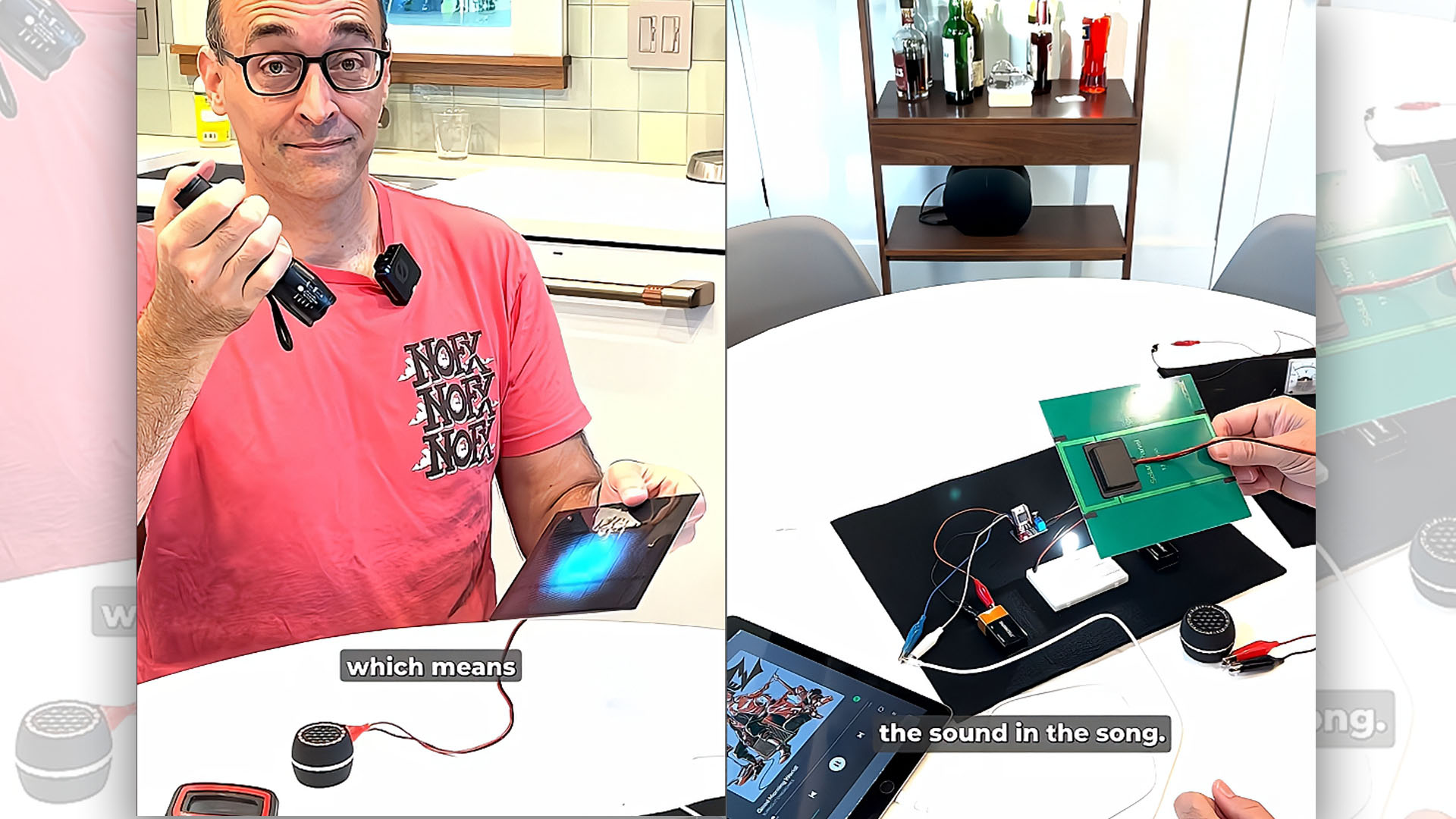Teacher uses cheap laser and solar panel to transmit wireless sound — iPad powers home project that was inspired by solar panel making noise when attached to speaker
This home experiment lets you make your own laser sound transmitter.

Phil, a high school chemistry teacher and YouTube creator, noticed that a small solar panel emitted a faint sound when connected to a speaker and exposed to light. From this, he deduced that he could transmit sound wirelessly using light, with the solar panel acting as a receiver. So, he decided to build a wireless transmitter using his iPad, a solar panel, and a cheap speaker, and shared the short build on his YouTube channel.
The first thing he did was to build an amplifier to strengthen the audio signal from his iPad, and then attach it to an LED light, both of which are powered by 9-volt batteries. The light would then vary its intensity when pressing play, indicating that the LED is receiving data pulses from the iPad as voltage variations. He then checked the voltage output of the amplifier, and, indeed, it synchronized with the music.
Phil tested his solar panel and speaker combo by placing it near the light, and it played the music from his iPad. The only downside is that if he moved the contraption just a few inches away from the bulb, the sound strength drops off proportionally to the inverse square law, which says that light intensity decreases by the square of the distance from the source.
To solve this, he replaced the LED with a cheap red laser diode that concentrated the light in a smaller area. He then pointed it a few feet away across his living room, and when he placed the tiny solar panel and speaker combo along the path of the laser, it started playing the music quite audibly. Sure, it might not be Hi-Fi quality with crisp sound, but it’s good enough that you’d understand the words of the song.
This isn’t actually groundbreaking technology, and the military has been using lasers to communicate wirelessly over long distances since the 1970s. It eventually entered civilian use in the 2000s, helping to establish high-speed communications in areas where laying fiber optic cables is impractical. It does have its limitations, though, especially since laser communications require a clear line of sight for them to work.
Still, Phil’s cheap and easy recreation of this technology showed how accessible it has become to nearly everyone. Moreover, his videos may spark the interest of students, helping to inspire the next generation of engineers and inventors.

Follow Tom's Hardware on Google News, or add us as a preferred source, to get our latest news, analysis, & reviews in your feeds.
Get Tom's Hardware's best news and in-depth reviews, straight to your inbox.

Jowi Morales is a tech enthusiast with years of experience working in the industry. He’s been writing with several tech publications since 2021, where he’s been interested in tech hardware and consumer electronics.
-
chaz_music Great article. When I was a kid, my Radio Shack project kit had an experiment for picking up the 60\120Hz hum from the incandescent bulbs using the kit solar cell. The filament thermal cycles twice per line cycle at each peak, so in the US that is 120Hz or in other parts of the world 100Hz for a 50Hz line frequency. I found that one experiment fascinating and decided to send a tone (not music) by LED to the solar cell. It worked but had tons of noise and distortion. As a kid, I obviously did not understand linearity with the LED and the BJT driving it, but it did kinda work.Reply
It was always a win when I did not smoke up a part in the kit. I also found with that kit that most LED colors will shift to orange when they are failing under thermal stress. If you saw orange, they were wetting the bed. And then that familiar putrid smell, and then lights out ...
Another trip on my bike to Radio Shack for LEDs. It is funny that I never thought to buy fuses. -
Sam Hobbs When I was in the Army in 1976 there was guy in the barracks whose responsibility was the laser communication system for the White House. Therefore I know that laser communications has been a real thing for more than half a century.Reply
This article seems to describe a complicated process of doing something that has existed for more than half a century. Instead of describing the system in terms of something totally new I am interested in understanding how this is a better than existing laser communication systems.
Also, the article title says transmit wireless sound. Sound is always wireless. -
ADAMGARY This project is a brilliant demonstration of ingenuity and accessible science. Using low-cost, everyday components to achieve wireless sound transmission makes complex principles tangible and exciting. It’s the kind of hands-on learning that sparks real curiosity and shows how creative teaching can bring physics to life. The fact that it was inspired by an observable real-world phenomenon makes the lesson even more powerful. More projects like this could truly inspire the next generation of engineers and inventors.Reply -
nocturn9x Reply
They probably meant transmitting sound *wirelessly*, but yeah. A wave can't be wired or wireless, it's a wave, lolSam Hobbs said:When I was in the Army in 1976 there was guy in the barracks whose responsibility was the laser communication system for the White House. Therefore I know that laser communications has been a real thing for more than half a century.
This article seems to describe a complicated process of doing something that has existed for more than half a century. Instead of describing the system in terms of something totally new I am interested in understanding how this is a better than existing laser communication systems.
Also, the article title says transmit wireless sound. Sound is always wireless.
